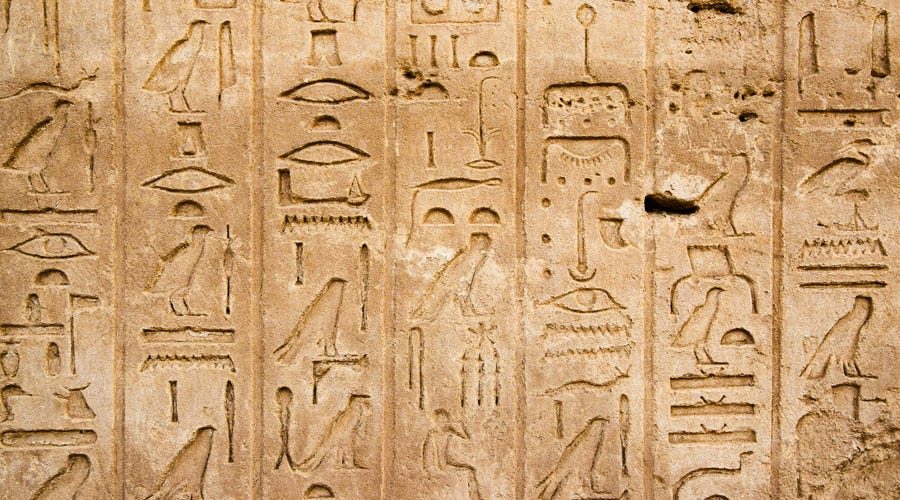
15 of the oldest languages in the world, including 12 still spoken
Author: Karolina Assi
If you’re a language enthusiast, you’ve surely felt curious about how languages came to be and what the oldest and most ancient languages are in the world. Maybe you even felt the urge to study one!
And if you’re reading this article, you surely have tons of questions: what’s the oldest language in the world? What was the first language ever spoken? What was the first language recorded in written form? Which ancient languages have gone extinct, and which ones have survived and are still spoken to this day?
We’ll try to answer all of these questions in this article. To write it, we embarked on a Google quest to compile our list of the 15 oldest languages in the world that are still spoken today.

So, what is the oldest language in the world?
What was the first language ever spoken? This question puzzles linguists because there’s no easy way to determine this. According to linguists, the oldest languages in the world date back to at least 4,600 years.
That’s a lot of years of language evolution! To answer this question, we first need to understand how language even came to be and how it evolved from drawings carved on cave walls to spoken words as we know them today.
But generally, linguists agree that the oldest languages spoken in the world were Sumerian, Akkadian, and Egyptian - at least the oldest ones with a clear written record.
Sumerian
The Sumerian language originated around 3100 BCE in ancient Mesopotamia and was the first language written in the cuneiform script. So, Sumerian cuneiform script is the oldest form of writing in the world, and it was used to communicate between merchants.
Akkadian
Akkadian is another language spoken in ancient Mesopotamia, dating back to 2500 BCE. It also used the cuneiform writing system and became the lingua franca of the region during the Akkadian Empire, pushing Sumerian out of the way and, eventually, completely replacing it.
Egyptian
Although Egyptian probably makes you think of the language spoken in Egypt, which is Egyptian Arabic, these are two completely different languages - sort of. They belong to the same language family - the Afro-Asiatic family - but to two different branches. Arabic is a Semitic language, while Egyptian is an entirely separate branch.
Egyptian is also the first language to develop a written form of communication - aka, the Egyptian hieroglyphs. The ancient Egyptian language evolved over millennia through several stages, including Old Egyptian, Middle Egyptian, Late Egyptian, Demotic, and finally Coptic, which is still spoken by a handful of people today as it’s still used as the liturgical language of the Coptic Orthodox Church of Alexandria.
12 oldest languages in the world, still used today
Sumerian, Akkadian, and Egyptian may be the oldest languages in the world, but they’re also extinct, meaning they have died out and are no longer in use today. So, another question pops up: what is the oldest living language in the world that’s still spoken to this day?
There is no clear winner of the Oldest Language in the World challenge, but there are a few solid contestants. Here are the 12 oldest languages in the world that are still spoken today.
1. Tamil
Tamil, one of the official languages of India, Singapore, and Sri Lanka, can be traced back to 300 BCE - or even longer than that, but that’s when the first literature written in Tamil was recorded. Tamil is considered to be the longest-surviving classical language in the world.
Fun fact: Tamil is so ancient that it has its own classical literature, which includes works like the Thirukkural, a collection of couplets on ethics, politics, and love written by the poet Thiruvalluvar over 2,000 years ago.
2. Sanskrit
Sanskrit, the liturgical language of Hinduism, Buddhism, and Jainism, dates back to around 2000 BCE. This ancient language is often referred to as the "language of the Gods" due to its extensive use in sacred texts such as the Vedas, Upanishads and epics like the Mahabharata and Ramayana.

Fun fact: Sanskrit's grammar was first codified by Panini in his work Ashtadhyayi, a text from around the 4th century BCE that is still studied today.
3. Chinese
Chinese is said to be one of the oldest written forms of language, dating back at least 6,000 years. However, the earliest written records of Old Chinese that have survived date back to 1250 BCE. The modern Chinese, spoken by over a billion people, has its roots in these ancient forms.
Fun fact: Did you know that Mandarin isn’t the only form of Chinese language spoken today? We also have Cantonese, Wu, Xiang, Putonghua, Min, Hakka, Gan, and more variations of the Chinese language. Read more articles on our Chinese language and culture blog here.
4. Greek
Greek is the language of great philosophers, mathematicians, and thinkers. It dates back to at least 1450 BCE and was the most widely spoken lingua franca in the Mediterranean world at that time. It was also the official language of the Byzantine Empire.
Ancient Greek evolved over centuries into Modern Greek, which is now spoken by over 13 million people and is the official language of Greece and Cyprus.
Fun fact: Did you know that the word “alphabet” comes from the first two letters of the Greek alphabet, “alpha” and “beta”?
5. Hebrew
Hebrew, a regional dialect of the Canaanite languages, was originally spoken by the Israelites. It was used regularly as a first language until after 200 CE and remained the liturgical language of Judaism and Samaritanism. In the 19th century, it was successfully revived as a spoken language, making it the only large-scale linguistic revival in history.
Fun fact: Today, Hebrew is the only surviving Canaanite language, and Aramaic is one of the two remaining Northwest Semitic languages still spoken.
6. Aramaic
Aramaic is a Northwest Semitic language that started in ancient Syria and spread to regions like Mesopotamia, the southern Levant (modern Jordan, Israel, and Palestine), Eastern Arabia, and the Sinai Peninsula. The earliest Aramaic writings date back to the 11th century BC, making it one of the oldest written languages.
Fun fact: Today, Aramaic is endangered, with its different varieties mainly spoken by older generations and groups like the Arameans, Assyrians, and some Mizrahi Jews.
7. Farsi
Persian, also known as Farsi, is a Western Iranian language spoken in Iran, Afghanistan, and Tajikistan, with different variations. It originated in Persia (modern-day Iran) and evolved from Old Persian into Middle Persian and modern Farsi. It dates back to around 550 BCE.
Fun fact: Persian has influenced many other languages, such as Urdu and Turkish, particularly in terms of literature and poetry.
8. Arabic
Arabic has a rich history that spans over 1,500 years. It’s a Semitic language that originated in the Arabian Peninsula. Old Arabic, the oldest known form of the language, dates back to the 4th century CE. It served as the language of the Qu’ran, Islam’s holy scripture. Now, it’s spoken by over 420 million people worldwide.

Fun fact: Over time, Arabic diversified into various dialects, such as Classical Arabic (also known as Quranic Arabic), Modern Standard Arabic (the one you hear on the news), and regional variations like Levantine Arabic (spoken in Lebanon and Syria), Egyptian Arabic (spoken in Egypt), etc.
9. Armenian
Armenian is an Indo-European language and the only member of its branch in the Armenian language family. Historically spoken in the Armenian highlands, it’s now the official language of Armenia. Armenian uses its own alphabet, which was introduced in 405 AD by Saint Mesrop Mashtots.
Fun fact: The Armenian alphabet was initially developed to translate the Bible, but it became widespread.
10. Irish Gaelic
Irish is a Goidelic language of the Celtic family, native to Ireland. It was the main language until the 19th century, when English became dominant. In fact, Irish is the oldest written language in northern Europe, with Ogham inscriptions dating back to the 4th century CE.
Fun fact: Today, Irish is primarily spoken by Gaeltacht regions, where 2% of Ireland’s population lived in 2022.
11. Basque
Basque is the only surviving Paleo-European language in Europe. It existed before the arrival of Indo-European languages and before Europe was Romanized in the 1st century BCE. Spoken in the Basque Country, it’s classified as a language isolate (meaning it has no genetic relationship with any other language).
Fun fact: Despite being a language isolate, Basque has borrowed 40% of its vocabulary from Romance languages like Spanish, French, and Italian.
12. Latin
Latin first appeared around the 7th century BCE in the region of Latium, which encompasses the city of Rome. As Rome expanded its territory, Latin spread throughout the Roman Empire, and it became the dominant language in many parts of Europe, North Africa, and the Middle East. As the Roman Empire began to decline, so did Latin, and it eventually evolved into the various Roman languages we know today, like Italian, French, Spanish, and Romanian.
Today, Latin is a “dead language,” which means that it’s no longer spoken as a native language. However, it still remains in use within the Roman Catholic Church, and many institutions and universities around the world still teach it. You may not even know it, but you’re already familiar with some Latin words like vice versa, status quo, per capita, circa, or et cetera.

Fun fact: Did you know that Latin is the source of over 60% of the English vocabulary? Many English words are derived from Latin, mainly those related to science, law, and medicine.
There’s more to the (hi)story
To learn everything there is to know about the oldest languages in the world, we’d need to comb through thousands of years of linguistic evolution and trace everything back to how the first humans communicated.
Naturally, we couldn’t cover the entire history of languages and all of the languages that appeared, disappeared, survived, and died out.
We hope this article has given you a good idea about the oldest languages in the world and a good foundation to go digging deeper - if you want.


